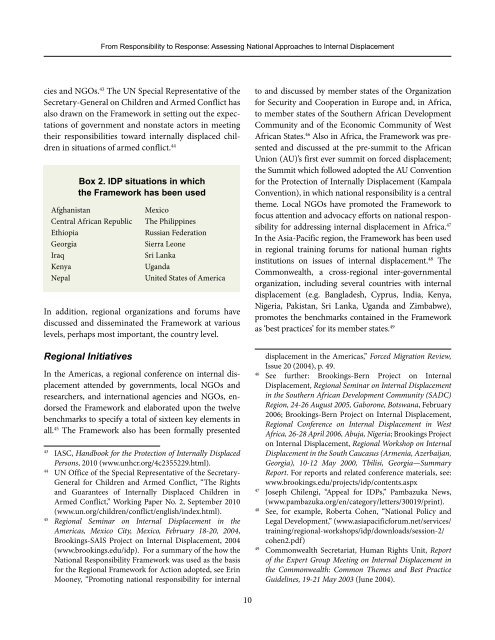From Responsibility to Response: Assessing National - Brookings
From Responsibility to Response: Assessing National - Brookings
From Responsibility to Response: Assessing National - Brookings
Create successful ePaper yourself
Turn your PDF publications into a flip-book with our unique Google optimized e-Paper software.
<strong>From</strong> <strong>Responsibility</strong> <strong>to</strong> <strong>Response</strong>: <strong>Assessing</strong> <strong>National</strong> Approaches <strong>to</strong> Internal Displacement<br />
cies and NGOs. 43 The UN Special Representative of the<br />
Secretary-General on Children and Armed Conflict has<br />
also drawn on the Framework in setting out the expectations<br />
of government and nonstate ac<strong>to</strong>rs in meeting<br />
their responsibilities <strong>to</strong>ward internally displaced children<br />
in situations of armed conflict. 44<br />
Box 2. IDP situations in which<br />
the Framework has been used<br />
Afghanistan Mexico<br />
Central African Republic The Philippines<br />
Ethiopia Russian Federation<br />
Georgia Sierra Leone<br />
Iraq Sri Lanka<br />
Kenya Uganda<br />
Nepal United States of America<br />
In addition, regional organizations and forums have<br />
discussed and disseminated the Framework at various<br />
levels, perhaps most important, the country level.<br />
Regional Initiatives<br />
In the Americas, a regional conference on internal displacement<br />
attended by governments, local NGOs and<br />
researchers, and international agencies and NGOs, endorsed<br />
the Framework and elaborated upon the twelve<br />
benchmarks <strong>to</strong> specify a <strong>to</strong>tal of sixteen key elements in<br />
all. 45 The Framework also has been formally presented<br />
43 IASC, Handbook for the Protection of Internally Displaced<br />
Persons, 2010 (www.unhcr.org/4c2355229.html).<br />
44 UN Office of the Special Representative of the Secretary-<br />
General for Children and Armed Conflict, “The Rights<br />
and Guarantees of Internally Displaced Children in<br />
Armed Conflict,” Working Paper No. 2, September 2010<br />
(www.un.org/children/conflict/english/index.html).<br />
45 Regional Seminar on Internal Displacement in the<br />
Americas, Mexico City, Mexico, February 18-20, 2004,<br />
<strong>Brookings</strong>-SAIS Project on Internal Displacement, 2004<br />
(www.brookings.edu/idp). For a summary of the how the<br />
<strong>National</strong> <strong>Responsibility</strong> Framework was used as the basis<br />
for the Regional Framework for Action adopted, see Erin<br />
Mooney, “Promoting national responsibility for internal<br />
10<br />
<strong>to</strong> and discussed by member states of the Organization<br />
for Security and Cooperation in Europe and, in Africa,<br />
<strong>to</strong> member states of the Southern African Development<br />
Community and of the Economic Community of West<br />
African States. 46 Also in Africa, the Framework was presented<br />
and discussed at the pre-summit <strong>to</strong> the African<br />
Union (AU)’s first ever summit on forced displacement;<br />
the Summit which followed adopted the AU Convention<br />
for the Protection of Internally Displacement (Kampala<br />
Convention), in which national responsibility is a central<br />
theme. Local NGOs have promoted the Framework <strong>to</strong><br />
focus attention and advocacy efforts on national responsibility<br />
for addressing internal displacement in Africa. 47<br />
In the Asia-Pacific region, the Framework has been used<br />
in regional training forums for national human rights<br />
institutions on issues of internal displacement. 48 The<br />
Commonwealth, a cross-regional inter-governmental<br />
organization, including several countries with internal<br />
displacement (e.g. Bangladesh, Cyprus, India, Kenya,<br />
Nigeria, Pakistan, Sri Lanka, Uganda and Zimbabwe),<br />
promotes the benchmarks contained in the Framework<br />
as ‘best practices’ for its member states. 49<br />
displacement in the Americas,” Forced Migration Review,<br />
Issue 20 (2004), p. 49.<br />
46 See further: <strong>Brookings</strong>-Bern Project on Internal<br />
Displacement, Regional Seminar on Internal Displacement<br />
in the Southern African Development Community (SADC)<br />
Region, 24-26 August 2005, Gaborone, Botswana, February<br />
2006; <strong>Brookings</strong>-Bern Project on Internal Displacement,<br />
Regional Conference on Internal Displacement in West<br />
Africa, 26-28 April 2006, Abuja, Nigeria; <strong>Brookings</strong> Project<br />
on Internal Displacement, Regional Workshop on Internal<br />
Displacement in the South Caucasus (Armenia, Azerbaijan,<br />
Georgia), 10-12 May 2000, Tbilisi, Georgia—Summary<br />
Report. For reports and related conference materials, see:<br />
www.brookings.edu/projects/idp/contents.aspx<br />
47 Joseph Chilengi, “Appeal for IDPs,” Pambazuka News,<br />
(www.pambazuka.org/en/category/letters/30019/print).<br />
48 See, for example, Roberta Cohen, “<strong>National</strong> Policy and<br />
Legal Development,” (www.asiapacificforum.net/services/<br />
training/regional-workshops/idp/downloads/session-2/<br />
cohen2.pdf)<br />
49 Commonwealth Secretariat, Human Rights Unit, Report<br />
of the Expert Group Meeting on Internal Displacement in<br />
the Commonwealth: Common Themes and Best Practice<br />
Guidelines, 19-21 May 2003 (June 2004).

















